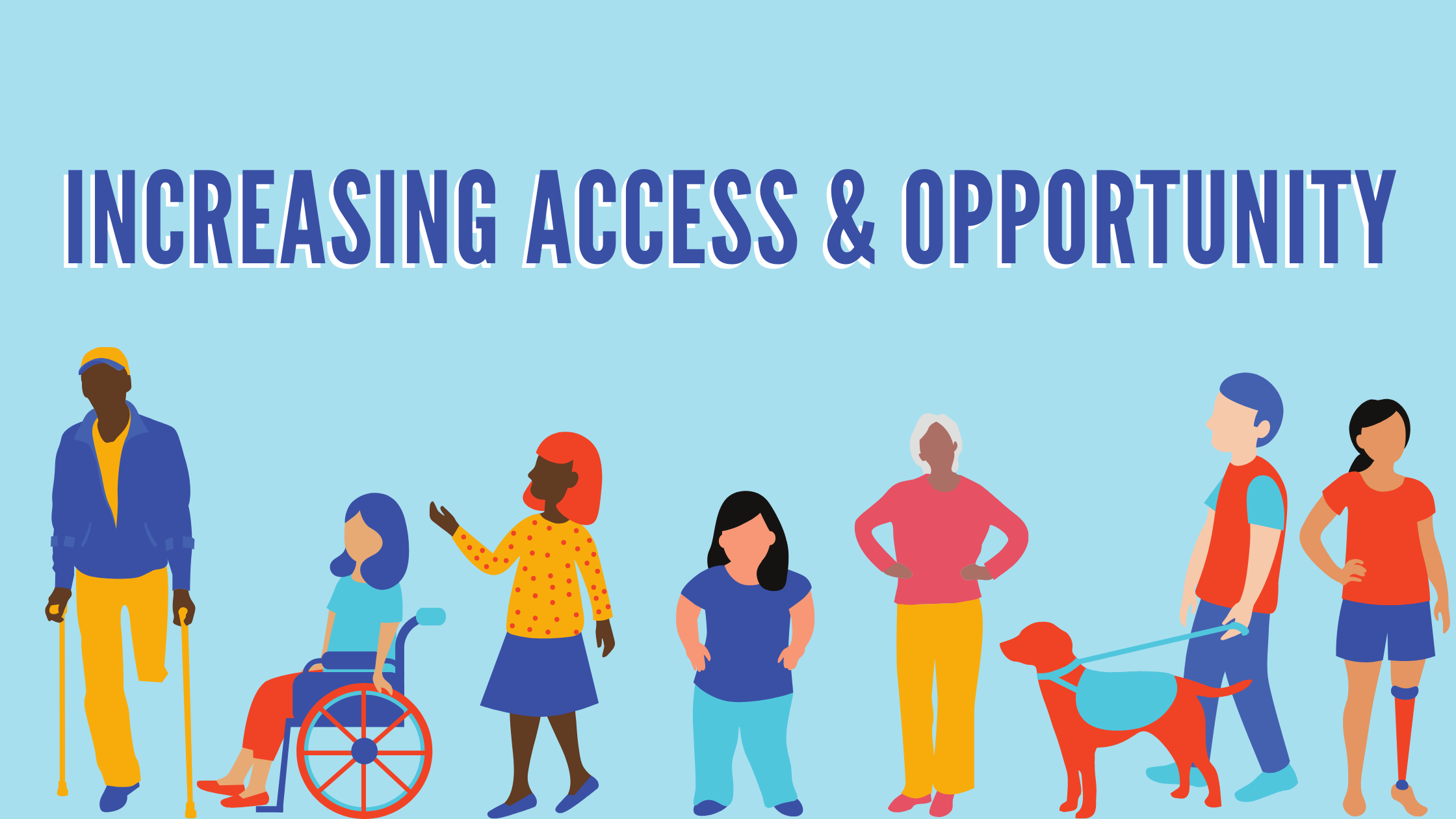Disability Inclusion: How Marketers Can Do Better

October was National Disability Employee Awareness Month (NDEAM), and it’s important to keep the conversation around disability inclusion alive year-round. As marketers, it is critical to understand disability inclusion and create workplaces and work that reflect our commitment to getting it right. Throughout October, Discover_TMA provided information and resources to educate employees on disability inclusion, allyship, and ways we can be supportive. Here are some highlights.
Ways We Can Do Better: Externally vs. Internally
Estimates consistently show 25% of the population has some sort of disability and the likelihood that you’ll be affected at some point in your life is very high. There are many types of disabilities, including physical, learning disabilities, visual or hearing impairments, and mental illness, including depression. Any of these can be temporary, permanent, or situational. A few things we can do externally vs. internally are:
WHAT WE CAN DO EXTERNALLY:
- Make our work accessible, not just meet the minimum standards and not only website design, but social content, experiential events, even print work.
- Lead and educate our clients on disability inclusion.
- Use disabled talent and vendors in our work.
WHAT WE CAN DO INTERNALLY:
- Make our workplaces more accessible and friendlier.
- Accommodations for disabled employees.
- Recruit disabled talent.
Ways We Can Do Better: By Department
Creative teams should design with accessibility in mind. Common issues are missing or inaccurate text alternatives for images, insufficient color contrast, non-accessible forms, and buttons without alt text. Additionally, reconsider jokes like making fun of “useless” products that can help people with disabilities, like banana slicers and pre-peeled oranges.
Producers should review content and point out issues, whether it be adequate contrast in print or video, or making sure an experiential event is accessible. They can also research and push for diverse and disabled talent, crew and/or vendors. When featuring a disability in advertising, use disabled talent!
Developers, UX, and QA employees can be encouraged to have Web Accessibility Specialist or other certifications.
Copywriters and Proofreaders should follow APA guidelines for bias-free language.
- AP Stylebook example: Do not use the wording “confined to a wheelchair” or “wheelchair-bound.” People use wheelchairs for independent mobility. If a wheelchair is needed and the description is relevant, say why. The term wheelchair user when relevant is OK.
- “Special needs” is not an accepted term in the disability community, yet is repeatedly used in major publications.
- Strive to understand the expressed preference for person-first or identity-first language.
Social Media teams should suggest and lead teams to develop accessible posts, including alt image text descriptions and open or closed captioning. In addition, social teams can regularly ask platform and third-party partners what advancements they’re making in accessibility and continually push them to improve.
Recruiting can work with hiring managers on job descriptions to remove ableist language and unnecessary requirements that could exclude disabled applicants. For applications, make accessible .pdfs, create charts and presentations that are concise and clear that don’t rely solely on color variations. This can help people with dyslexia, color vision deficiency, or low vision.
Lastly, no matter your department, it’s important to remember some disabilities are invisible and some employees may be reluctant to identify as having a disability.
Ways to Continue Supporting
DONATE: There are so many great ways to get involved and support a cause, but a financial contribution can make all the difference when it comes to making an impact. Discover TMA is proud to announce that a donation has been made to Special Olympics on behalf of TMA. If you’re interested in getting involved or supporting this cause, you can find more details here.
LEARN: While you continue your journey, here are some additional avenues for ongoing learning.
Read
- Disabled People Don’t Want to Be Your Inspiration, But If They Are It’s No Surprise
- What Is Life Really Like for Disabled People? The Disability Diaries Reveal All
- How To Make Your Workplace Disability Friendly
- Haben: The Deafblind Woman Who Wonquered Harvard Law, by Haben Girma
- A Disability History of the United States, by Kim E. Nielsen
- Disability Visibility: First-Person Stories from the Twenty-First Century, by Alice Wong
- Branding & Designing Disability, by Elizabeth DePoy and Stephen Gilson
Listen
- Equality and Authentic Representation in Hollywood with Jay Ruderman
- Equal Too: Design for all
- Disabled “Fakers”
- Intersectionality
- “Curb Cuts” – 99% Invisible Podcast, Episode 308, (52:44)
Watch
- Crip Camp: A Disability Revolution
- TED x Why We Need Universal Design
- TED x Sydney: I’m Not Your Inspiration
Research
- https://www.nytimes.com/2018/05/30/opinion/disability-design-lifehacks.html
- https://www.wired.com/story/its-time-to-rethink-whos-best-suited-for-space-travel/
- https://www.nature.com/articles/d41586-020-01312-w
- https://slate.com/technology/2021/02/nike-go-flyease-shoe-disabled-design.html?via=rss_socialflow_twitter
- https://www.forbes.com/sites/andrewpulrang/2020/02/13/disability-movies-arent-what-they-used-to-be-thats-good/?sh=3a4b58d95efa
- https://www.forbes.com/sites/andrewpulrang/2020/01/03/4-ways-to-understand-the-diversity-of-the-disability-community/?sh=275b9b393d3e
Follow
- @SFdirewolfand (Alice Wong) // Twitter
- @Imani_Barbarin // Twitter
- @mauldin_laura // Twitter
- @HabenGirma // Twitter
- @_louhicky // Twitter
- @SeeMiaRoll // Twitter
- @judithheumann // Twitter
- @carlyfindlay // Twitter
- @elizejackson // Twitter
- @sinsinvalid // Twitter
- @CatchTheseWords / Twitter
- @snarkbat // Twitter
- @disability_visibility // Instagram
- @mia.mingus // Instagram
- @deafetiquette // Instagram
- @crutches_and_spice // Instagram
- #TransformativeJustice // Instagram Hashtag
- #DisabilityJustice // Instagram Hashtag
We hope these insights and resources are helpful and that you will join TMA in our quest to getting disability inclusion right in our workplace, work, and beyond.
References
- Disability inclusion at work: https://www.forbes.com/sites/andrewpulrang/2020/01/03/4-ways-to-understand-the-diversity-of-the-disability-community/?sh=275b9b393d3e
- Disability laws in the workplace: https://www.eeoc.gov/disability-discrimination
- Examples of adjustments/modifications that are often requested by visually impaired or blind employees: https://www.perkins.org/services/workplace/employers/workplace-accommodations
- Workplace accommodations for employees with hearing loss: https://hearinghealthfoundation.org/hearing-loss-in-the-workplace
About Discover_TMA
Discover TMA, our diversity and inclusion initiative, was created with the purpose of expanding agency understanding of the diverse people at the heart of our culture through content, education, and conversations.


